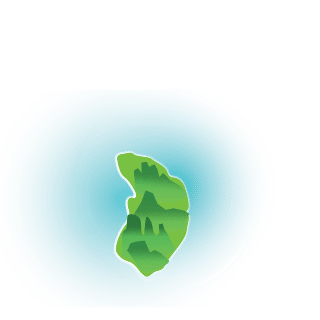Tahitian Legends
Like other cultures, the people of Oceania created mythic stories to explain the creation of their incredibly beautiful islands. These tales are steeped in love, jealousy, rage, destruction, rebirth, and the beauty of nature. The islands of Polynesia share many of the same pu ma, or deities, but local lore can vary greatly from island chain to island chain. What one god or goddess was up to in the Hawaiian Islands, was often completely different than the stories told about he or she in Tahiti.

The Myth of the Coconut
It’s a Polynesian myth that the universe sprung forth from a coconut. It makes sense when you think about how important the coconut was to sustaining the early islanders; providing food and drink, and thatch for shelter. But where did that idea originate?
According to one legend, Hina, the beautiful goddess princess and granddaughter of the moon, was betrothed to the king of Lake Vahiri. Unfortunately her fiancé was a large repulsive eel. Frightened by him, Hina sought protection from the god Maui.
When the eel came looking for her, Maui caught him on a hook, to which the eel cursed his future bride. “You may be repulsed by me, but one day you will be compelled to kiss me and like it.”
Maui beheaded the eel, wrapped the head in a tapa cloth, and presented it to Hina with the warning that she not put it on the ground until she returned home. But the traveling Hina forgot, and left it on a sand beach. From the head of her spurned lover, the first shoots of the coconut palm emerged.
It is said that, when you drink from the end of a coconut, you can still see the eyes and mouth of the eel.
Polynesian mythology offers up an array of colorful deities. Their specific names and specialties often vary depending on locality. Here are just a few:

Tangaroa
God of the Sea

Tane
God of Beauty and Peace

Hina
Moon Goddess

Pare
Goddess of Volcanoes

Haka
Goddess of Sky and Earth
Mo'Orea And The Yellow Lizard
Once upon a time there was a man called Tematiatea. He and his wife lived on the isle of Aimeho, near Tahiti, and they were going to have a child. When Tematiatea’s wife’s time came she gave birth to an egg, which she hid in a cave. That night she dreamed her child would be a yellow boy. The husband kept guard over the cave until the egg hatched and a baby yellow lizard was born. They named their son Mo’orea. The husband and wife hid the lizard in a grotto on the island. After a time, their son grew so large that the woman was afraid that he would eat them. Fearing for their lives, the husband built a canoe and the couple set out on a grand journey for the isle of Tahiti. The despondent Mo’orea missed his parents, and set out swimming after them in the direction of the sun. During his journey he fought the ocean currents, became exhausted, and died. His large body drifted back up onto the shore of Aimeho, where two fishermen found him and ran to tell the other villagers of the gigantic yellow lizard. To this day the island of the lizard is called Moorea.

The Creation Of The Marquesas
One Polynesian legend has it that in the beginning there were Oatea and Atanua, the first man and woman. They ruled the oceans when the world was very young. Oatea wanted to surprise and delight his wife, so he channeled his divine powers and called upon the gods to help him build Atanua a house, to be finished before dawn the next day. As the sun began to set, he chose a site in the middle of the ocean called Tuaka. He built two posts, which became the island of Ua Po. He then added a long beam, which he called Hiva Oa. The rafters of the house became Nuku Hiva. With palm fronds woven together to form a thatched roof, Oatea created Fatu Hiva. As the sun began to rise the next morning, Oatea’s energy began to ebb. He quickly threw the leftover scraps of wood and thatch into a pit, which became the isle of Eiao.
When his wife awoke to a beautiful birdsong, Oatea told her that is was the isle of Motane. Finally, as sunshine crested on the horizon, Oatea named that Tahuata. And that is how paradise was built—with palm trees, birdsong, and sunshine. Atanua’s new home became the Marquesas Islands.

Fatu Hiva

Nuku Hiva

Hiva Oa

Tahuata
The Legend of the Tahitian Black Pearl

It is believed that pearls were the first instances of light, presented to the god Tane a long, long time ago. Tane used these little balls of light to illuminate the heavens before deciding to stud the dark night sky with them, creating starlight. He brought the pearls to Rua Hatu, the god of the ocean, so that the oceans could be set aglow with the pearls’ iridescence. After sharing the gift among the gods, Oro, the god of war and peace, gave the pearls to human women as tokens of love and affection. He encased the pearls in clam-like shells and gave the first pearl oysters, Te Ufi, to the Polynesian people. And to this day, the Pinctada Margaritifera pearl has flourished in the South Seas.